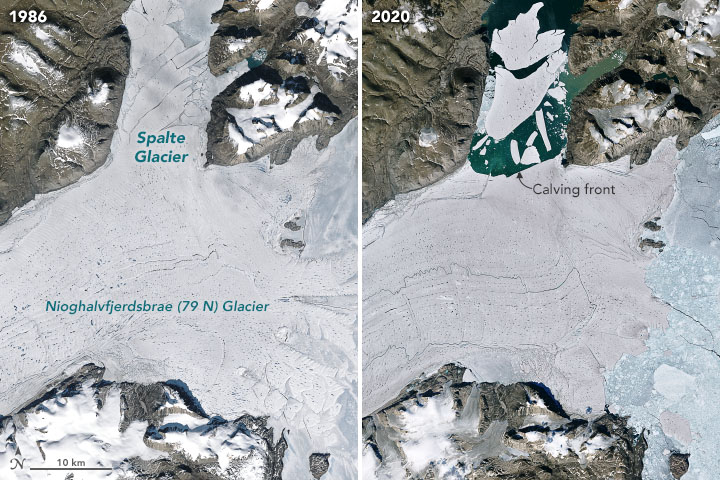


“Spalte” is a Danish verb meaning “to split.” The aptly named Spalte Glacier in northeast Greenland once branched off from its parent glacier, Nioghalvfjerdsbrae (79 N), which is the Arctic’s largest remaining ice shelf. In late June 2020, Spalte completely split off from its parent and crumbled away into numerous icebergs.
Scientists have been watching Spalte Glacier crack, shed ice, and retreat for decades. But the loss of 113 square kilometers (44 square miles) of ice in summer 2020 means that the branch of floating ice on the northeast side of 79 N is essentially gone for good. Scientists say the recent loss of Spalte, and the subtler changes to the adjacent 79 N, are part of a “progressive disintegration” that has happened amid unusually warm temperatures in recent years.
The pair of satellite images above show changes in the region across three decades. The right image was acquired with the Operational Land Imager (OLI) on Landsat 8 on July 24, 2020, nearly one month after Spalte Glacier broke up. For comparison, the left image from Landsat 5 shows the glacier system on August 16, 1986.
The icebergs in the 2020 image had already started drifting north in Dijmphna Sound after breaking away on June 30. “More rifts are already visible just southwest of the calving front indicate the 79 N floating ice tongue is not in good shape,” said NASA/UMBC glaciologist Christopher Shuman.
Also visible in the 2020 image is a long, gray line with curves that resemble the line plot from a seismograph; this is actually a seasonal river of liquid water that runs along the top of the glacier. The location of the bends in the river, which move with the glacier, can be correlated to stationary rocky landmarks and used to track the overall flow of the ice. For now, the ice at the main front of 79 N in Nioghalvfjerd Fjord is relatively steady, but recent research indicates further changes are likely to come.
About six small islands and submerged rocky “pinning points” help hold the floating front of 79 N in place. Two of the larger islands are clearly visible in these images. According to Shuman, another small island in the northern fjord may once have been crucial for holding Spalte Glacier in place into the 1970s. “This is the only ice shelf I know of that is fronted by so many distinct bedrock features,” he said.
Even after the loss of Spalte Glacier, 79 North remains the Arctic’s largest ice shelf, measuring about 70 kilometers long and 20 kilometers wide. Together with neighboring glaciers Zachariæ Isstrøm and Storstrømmen, the three glaciers are part of the Northeast Greenland Ice Stream and are the main outlets through which land-based ice can be drained from a 200,000-square-kilometer section of the Greenland Ice Sheet.
NASA Earth Observatory images by Joshua Stevens, using Landsat data from the U.S. Geological Survey. Story by Kathryn Hansen.